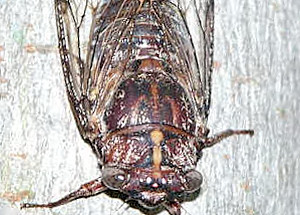|
| |
Family Cicadidae
- This page contains pictures and information about Cicadas in subfamily
Tibicininae that we found in the Brisbane area, Queensland, Australia.
-
 - Female laying eggs on stem
-
- Subfamily Tibicininae includes mostly small to medium size cicada
species. They usually rest on stems instead of tree trunks. Many of
them inhabit grass.
-
Tribe Taphurini
- Floury Baker


 - Aleeta curvicosta (Abricta curvicosta), body length 35mm
- The Floury Baker Cicada is dark brown in colour with lighter brown centre
line on thorax. Its abdomen is rather 'floury' look so has its common name.
Wings are clean, with two spots near the tip on each forewing. They are common in Brisbane. Their song start with zeep-zeep-zeep phrases, about
one zeep per second when start, then faster and faster until become a long
zeep sound. They like to sit on tree trunk and face downwards. We recorded
their song.
For more
details please visit our Floury Baker page.
Tribe Cicadettini
- Bark Squeaker
 
 - Pauropsalta corticinus,
body length 20mm
- We took the above photos on mid summer in
a Eucalyptus forest near Mt-Cotton. The cicada was at rest on a young Acacia
tree. The cicada was quite camera friendly, it let me take a few photos very
closely before it flew away. Check this page
for more information.
-
-
- Small Bark Squeaker
-
 

- Pauropsalta fuscata, body length 18mm, male, female
- We found this small cicada resting on young gum tree stem in Karawatha
Forest on a cloudy summer day. It did not fly away even we tried to catch it. Female laying eggs on stem. Please visit this
page for more pictures and information.
-
-
- Bronze Bark-buzzer


 - Pauropsalta circumdata, body length 20mm, male, female
- We found this cicada specie does not afraid of human. Different of them
had land on our body a few times. This one even land on my hand and let me
have the close inspection. Please check this page
for more information.
-
-
- Wattle Cicada, Thin-striped Wattle Cicada
 
 - Cicadetta oldfieldi, body length 20mm
- We found a few times those cicadas rest on the Hibiscus in our back
yard during early summer. As their name implies, the cicada also found on Wattle (Acacia)
tree. Their body is green in colour with brown
marking on thorax. Their compound eyes and three simple eyes are
reddish-brown, which are outstanding from their green head. Their wings are clear
with thin black veins. Fore more pictures and information please click on here.
-
-
- Black Tree-ticker


 - Birrima varians, body length 30mm
- This cicada is common in Brisbane bushland and eucalypts forests. They are
active flyers. Flight is fast and erratic, often changing direction. Most
other cicadas sing when rest. This cicada sings during flight. Their song is
a repeated series of "quack quack ........." phrases. Females
usually rest on smooth bark gum trees. Check this page
for more information.
Tribe Chlorocystini
- Small Bottle Cicada
   - Chlorocysta vitripennis, (Chlorocysta congrua), body length 20mm
- This cicada is green in colour. Its abdomen is relative large. Wings
are clear with green veins. It is not difficult to found them singing in our
backyard during summer.
When they sing, they only sing for about 4 seconds, and then stop for tens
of seconds. More information on the Small Bottle Cicadas page.
-
-
- Bladder Cicada
 
 - Cystosoma saundersii, body Length 50mm
- We first found this Bladder Cicada in the front yard of our friend in
Nambour,
about 100km north from Brisbane. We heard a very loud noise when we arrived
our friend's house in a summer late evening. At first I thought there was the
problem of my car engine. Then we found that the noise was coming from a
tree next to our car. Carefully inspection, we saw this Bladder Cicada
resting among leaves. We
brought it home and put in on tree in our backyard. We can hear this
loud noise for a few days. Unlike other cicadas which always calling during
the day, Bladder Cicada only calling for a short while after dark in the
evening. We have recorded its sound and some other details, please visit this page.
- Reference:
- 1. Insects
of Australia, CSIRO, Division of Entomology, Melbourne University
Press, 2nd Edition 1991, pp 464.
- 2. Australian Cicadas - Moulds MS (1990). New South Wales University Press, NSW. Australia.
Back to Top
[ Up ] [ Cicada Biology ] [ Cicadinae ] [ Tibicininae ]
| |
|

























